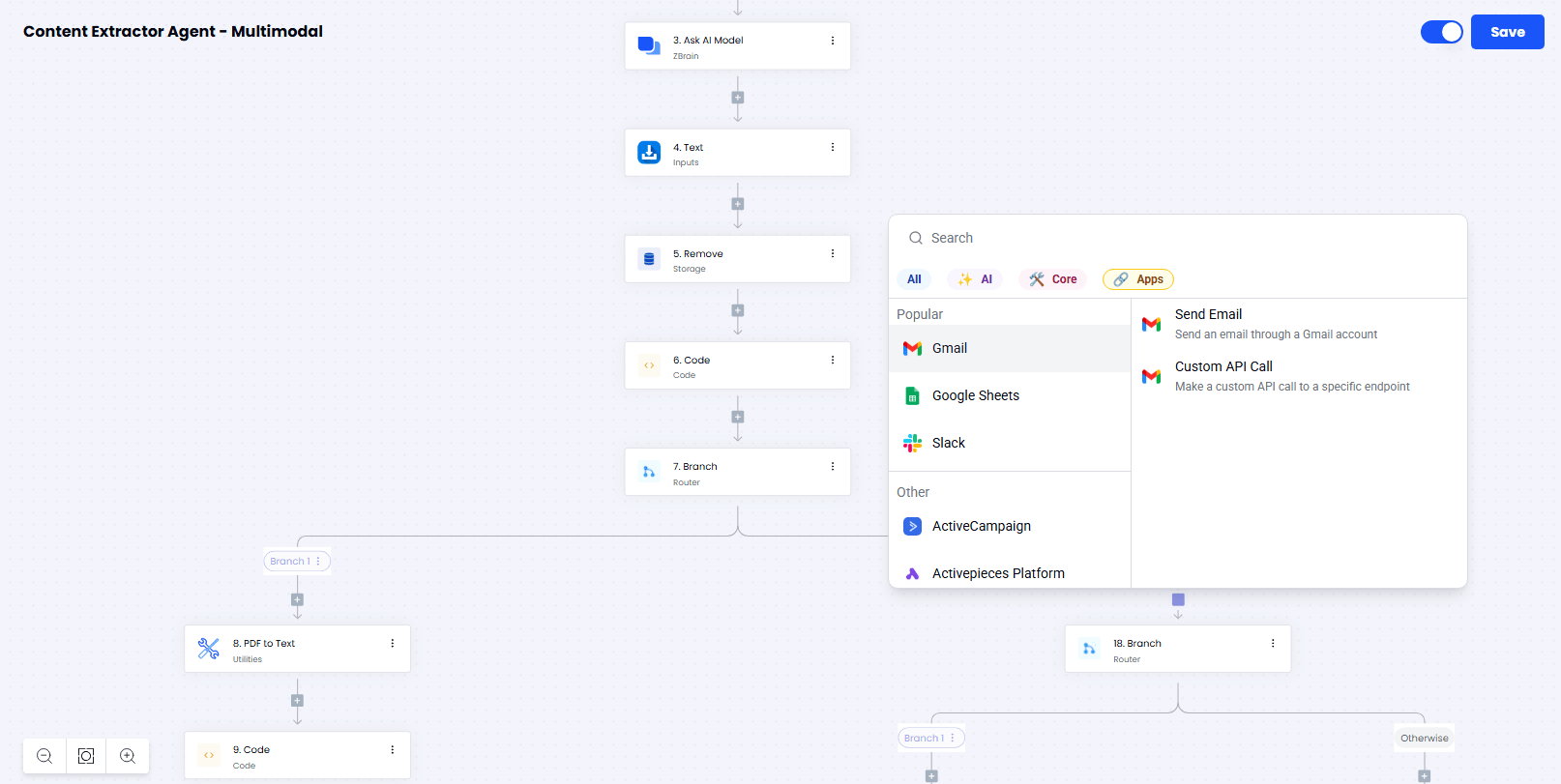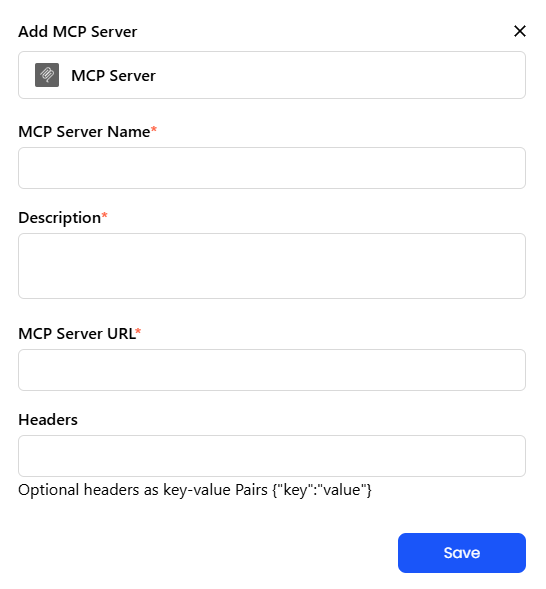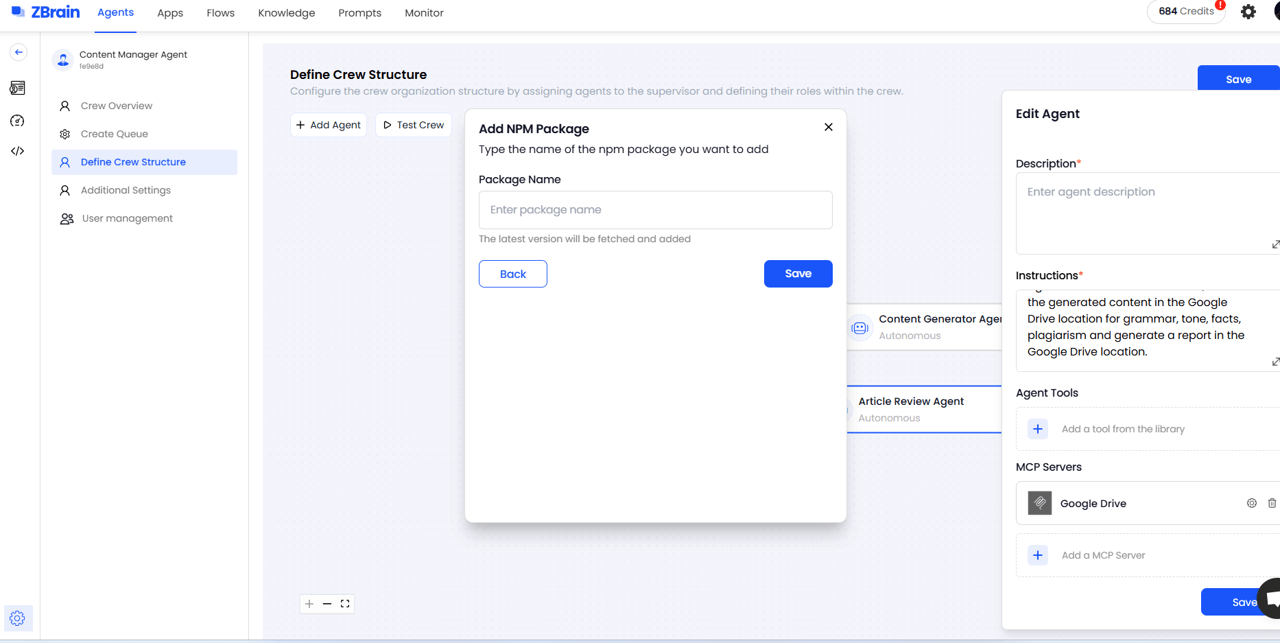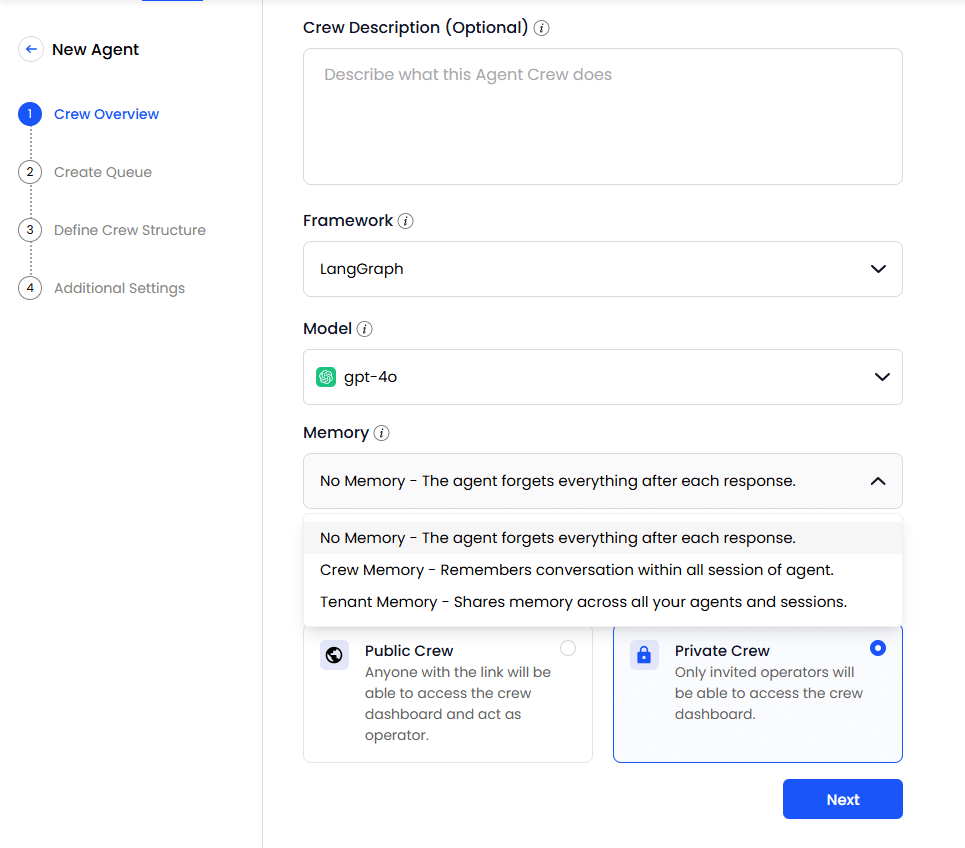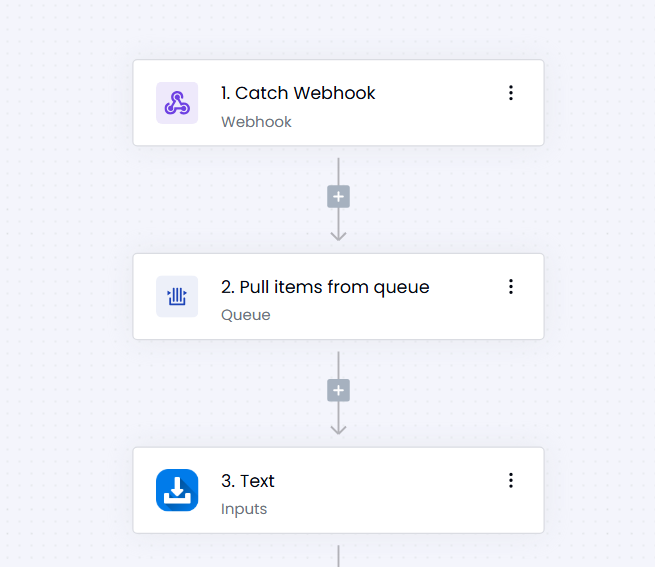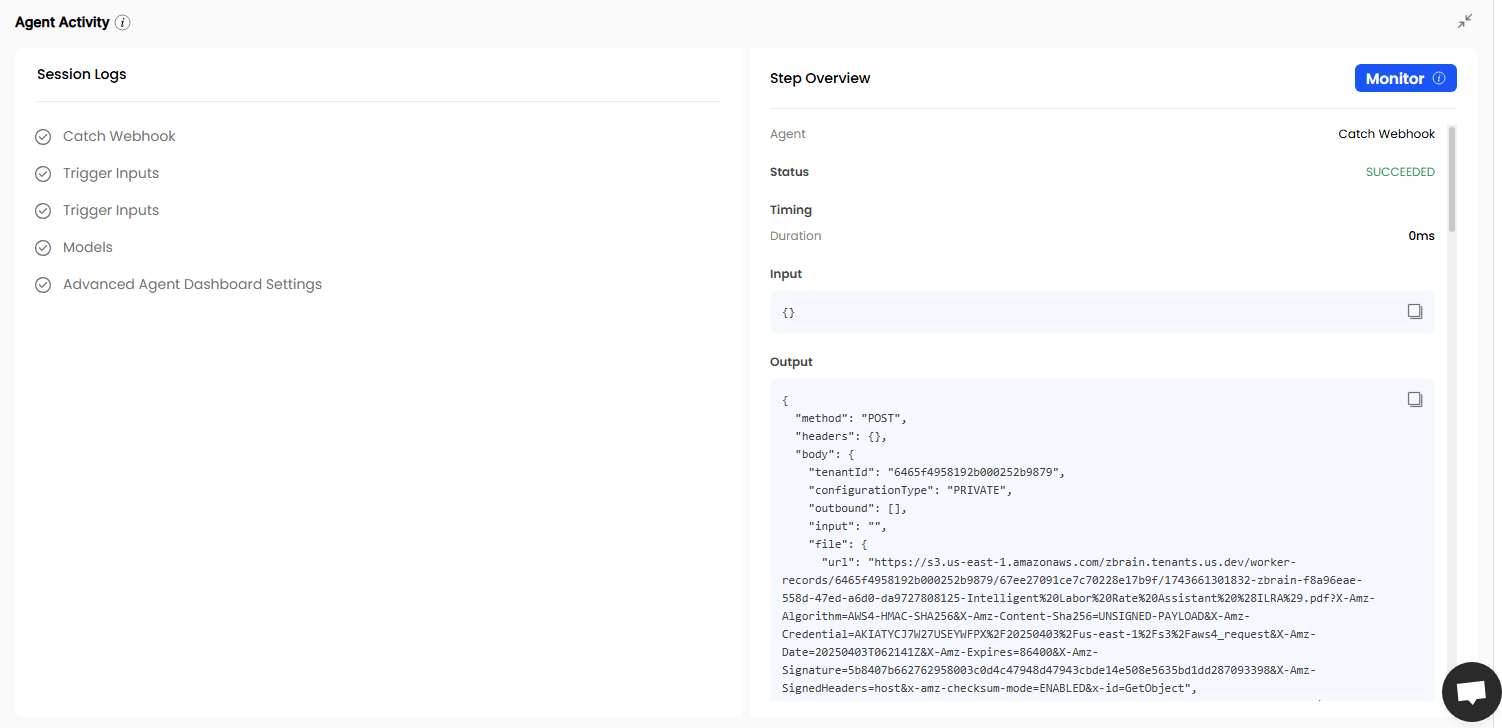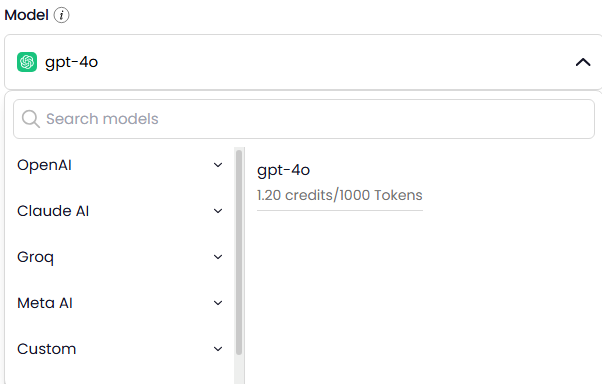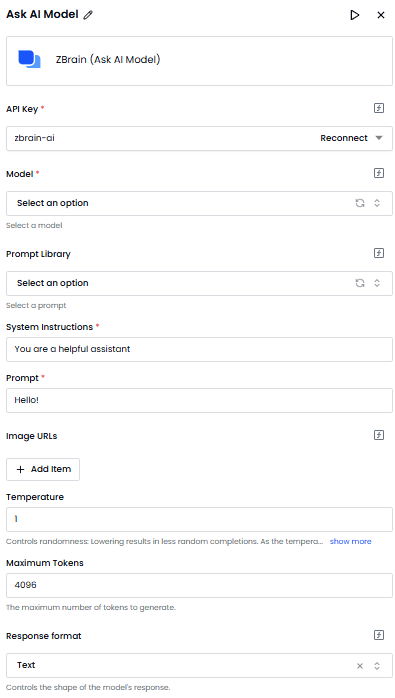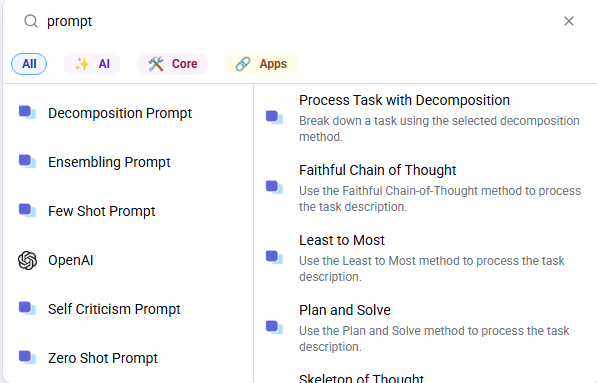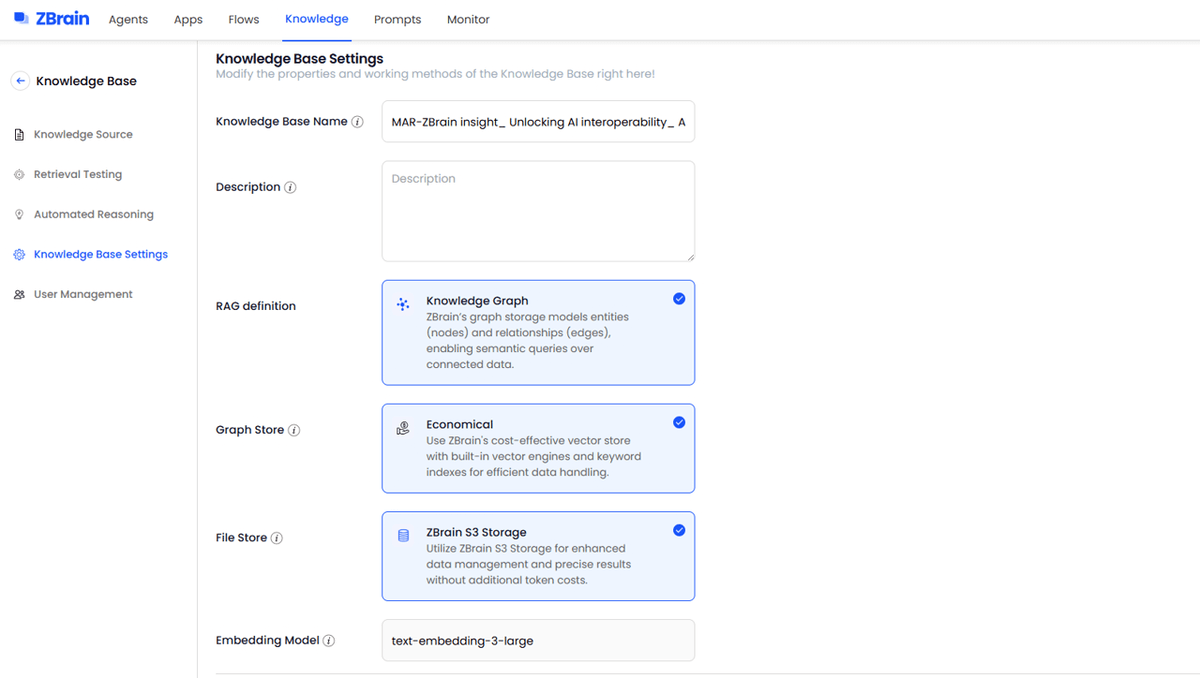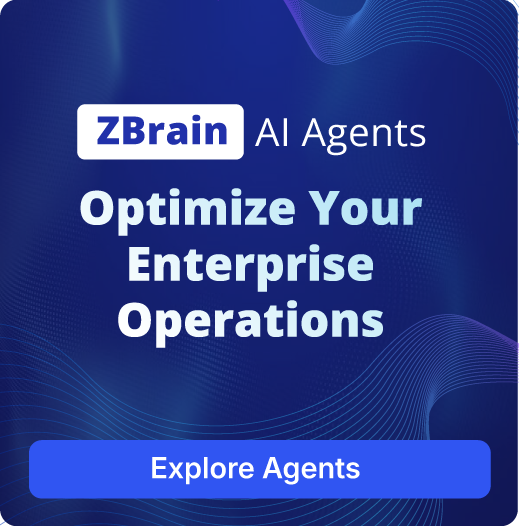Agent scaffolding explained: The framework for building enterprise-ready AI

Listen to the article
As enterprises begin to operationalize large language models, the gap between the capabilities of base models and production-ready systems becomes more apparent. A single LLM is not enough to reliably complete multi-step tasks, interface with business tools, or adapt to domain-specific logic. Bridging this gap requires an architectural layer often referred to as agent scaffolding—a modular framework of prompts, memory, code, tooling, and orchestration logic that surrounds the LLM to transform it into a usable, goal-driven agent. Whether an agent is expected to generate structured outputs, interact with APIs, or solve problems through planning and iteration, its effectiveness depends on the scaffold that guides and extends its behavior.
This article explains what agent scaffolding is, why it’s essential, and how different scaffolding strategies shape agent performance. It also outlines common scaffold types, frameworks built around them, and how modern platforms—including ZBrain—enable businesses to configure, test, and deploy scaffolded agents without complex engineering overhead.
- What is agent scaffolding?
- Types of agent scaffolds
- Core scaffolding components and architecture
- Origins and evolution of the concept
- Functional scaffolding techniques
- Use cases and examples of agent scaffolding
- ZBrain Builder: A platform for building scaffolded agents at enterprise scale
- Challenges, limitations, and best practices
What is agent scaffolding?
Agent scaffolding refers to the software architecture and tooling built around a large language model (LLM) to enable it to perform complex, goal-driven tasks. In practice, scaffolding means placing an LLM in a control loop with memory, tools, and decision logic so it can reason, plan, and act beyond simple one-shot prompts. In other words, instead of just prompting an LLM with a single query, we build systems (agents) that let the LLM observe its environment, call APIs or code, update its context or memory, and iterate until the goal is reached. These surrounding components – prompt templates, retrieval systems, function calls, action handlers and so on – form the scaffolding. They augment the LLM’s bare capabilities by giving it access to tools, domain data, and structured workflows.
For example, the Anthropic team, in one of their learning resources, describes an augmented LLM where the model can generate search queries, call functions, and decide what information to retain. Each LLM call has access to retrieval (for external facts), tool-calling (for actions like database queries or code execution), and a memory buffer (for keeping state). Scaffolding also includes prompting patterns or chains that break tasks into steps, and coordination logic that determines which agent or tool to invoke next. The key idea is to structure the agent’s workflow rather than relying on a single free-form query. Scaffolding is code designed around an LLM to augment its capabilities, giving it observation/action loops and tools to become goal-directed.
Types of agent scaffolds
LLM agents can be scaffolded in multiple ways depending on the complexity of the task, the execution environment, and the desired reasoning capabilities. Four foundational types of agent scaffolds have emerged through experimental research, particularly in technical problem-solving domains.
|
Scaffold type |
Key characteristics & purpose |
|---|---|
|
Baseline scaffold |
Includes planning, reflection, and action phases. LLMs are prompted to think, plan steps, execute, and then reflect on outcomes—creating a structured reasoning loop that significantly improves performance over simpler setups. |
|
Action-only scaffold |
Removes planning/reflection. Agents perform actions in a reactive loop. Useful for testing raw execution ability, but lacks the reasoning support of the baseline. |
|
Pseudoterminal scaffold |
Provides a direct interface to a terminal shell with real-time state. Ideal for tools/tasks needing active system interaction—e.g., multi-command workflows. It enhances expressivity and effectiveness in command-heavy environments . |
|
Web search scaffold |
Enables on-demand internet queries. Useful when external knowledge is required beyond the agent’s training data. Adds knowledge augmentation capacity. |
Core scaffolding components and architecture
Autonomous agents operate in a loop of perception, reasoning, and action. The user (or environment) provides an input prompt, the agent’s brain (LLM) formulates a plan or answer (possibly invoking tools or sub-agents), executes actions, and then repeats until the task is done.
The diagram above illustrates this agentic loop: a human prompt goes into an agent module, which calls the LLM (for reasoning and tool-selection) and triggers external tools; the results are fed back into the agent until the final result is produced. This loop – often framed as Perceive–Plan–Act or ReAct (Reason+Act) – is the backbone of agent scaffolding.
Within this loop, scaffolding provides several key layers:
- Planning & reasoning: Agents generally operate through a defined series of reasoning and evaluation steps. For example, a baseline scaffold might prompt the model to first plan or reflect before acting, whereas an action-only scaffold skips planning. Empirical work shows that allowing an agent to plan and self-critique (rather than acting immediately) can significantly improve problem-solving accuracy. In practice, this means embedding chain-of-thought prompts or explicit plan-reflection phases in the loop.
- Memory & context: Scaffolds often provide external memory stores so agents can recall past information and maintain long-term context. Instead of relying solely on the LLM’s limited prompt window, frameworks integrate vector databases or knowledge graphs for memory. For example, agents may log each answer into a retrievable memory; when needed, the scaffold retrieves relevant past context for the model to consider. This memory buffer lets agents handle much longer horizons than a raw LLM prompt permits.
- Tool integration: Scaffolding connects the agent to external tools, APIs, or knowledge bases. The LLM is wrapped in code that can interpret its outputs as tool calls. For instance, if the model decides it needs a calculator or a web search, the scaffold executes that tool and returns results to the model. Good scaffolding ensures seamless handoff: the model focuses on reasoning, and the scaffold safely runs the tools (e.g., calling a database, API, or math library) and feeds back the results for the next reasoning step.
- Feedback & control: Robust agents include feedback loops and safeguards. Scaffolds may include self-evaluation steps (asking the agent to critique or verify its own answer) or implement human-in-the-loop checks. They can also enforce policies: e.g., halting if the agent’s plan violates safety constraints. In enterprise settings, scaffolding often adds logging, testing suites, and guardrails (like content filters) around the agent to ensure outputs remain controlled.
Together, these components – planning, memory, tools, and feedback – form a layered architecture.
Origins and evolution of the concept
The term scaffolding was adopted by the AI community in recent years to capture the metaphor of building support structures around an LLM. Early use of the word in this context appears in work on LLM chaining interfaces (e.g., PromptChainer, 2022) and alignment discussions. People began calling any such wrapper or controller around an LLM a scaffold because it frames and supports the model as it works. The concept has evolved rapidly alongside multi-agent and chain-of-thought techniques. For example, chaining prompts or tree-of-thought methods effectively scaffold an LLM by enforcing step-by-step reasoning. Research platforms like OpenAI’s O1 evals and Anthropic’s Claude have long used a two-process design: one server for inference and a separate scaffold server that maintains agent state and invokes actions.
In practice, the rise of tools and multi-step pipelines (RAG, function calls, agent SDKs) from 2022 to 2025 transformed loosely structured prompts into full-blown agent frameworks. Companies and open-source projects began building standardized multi-agent platforms, each embodying principles of scaffolding. For instance, the CAMEL framework (2023) introduces distinct role-based agents (user, assistant, task-specifier) that communicate to solve tasks. Microsoft’s AutoGen (2024) offers Python libraries for developing chatbot-style agents that interact with tools and even involve humans in the loop. LangChain’s LangGraph (2024) and Google’s Agent Development Kit (2024) formalized stateful orchestration layers for agents. In parallel, AI safety researchers used the scaffolding metaphor to analyze potential failure modes, emphasizing how agents might misuse their scaffolding to self-improve or evade controls.
Overall, what started as ad-hoc prompt engineering has become an architectural pattern: placing an LLM at the heart of a modular system of tools, memory, and logic. The evolution continues rapidly – even enterprises are now offering agent orchestration platforms like ZBrain Builder that package scaffolding capabilities for non-specialists.
Functional scaffolding techniques
Agent scaffolding is the architectural layer that specifies how external systems integrate with and extend the capabilities of a large language model. While some scaffolds focus on improving prompt composition or on-the-fly retrieval of external data, agent-oriented scaffolds take it a step further, surrounding the LLM with planners, memory, and tool integrations, enabling it to pursue high-level goals autonomously. Below are several widely recognized scaffolding techniques used across frameworks and research implementations:
- Prompt templates: These are basic scaffolds where static prompts are embedded with placeholders to be filled in at runtime. They enable contextual inputs without hardcoding new prompts every time. Example: “You are a helpful assistant. Today’s date is {DATE}. How many days remain in the month?”
- Retrieval-augmented Generation (RAG): RAG is another basic scaffold that enables LLMs to access relevant information by retrieving context from structured or unstructured data sources. At inference time, retrieved snippets are injected into the prompt to ground the model’s outputs in up-to-date or domain-specific knowledge.
- Search-enhanced scaffolds: Instead of relying on internal training data alone, this scaffold allows an LLM to issue search queries, retrieve web content, and incorporate findings into its reasoning. Unlike RAG, the model decides what to search for and when to initiate it.
- Agent scaffolds: These scaffolds transform an LLM into a goal-directed agent capable of taking actions, observing results, and refining its steps. The agent is placed in a loop with access to memory, tools, and a record of past observations. Depending on the framework, agents may also receive high-level abstractions or tools to reduce repetitive, low-level operations and improve task efficiency.
- Function calling: This scaffold provides the LLM with structured access to external functions. It can delegate calculations, lookups, or operations to backend systems or APIs. For instance, instead of generating arithmetic solutions in free text, the LLM might call a defined sum() or use a spreadsheet API to ensure precision and reproducibility.
- Multi-LLM role-based scaffolds (“LLM bureaucracies”): In this setup, multiple LLMs are assigned specialized roles and interact in structured workflows, like teammates in an organization. A common setup involves one LLM generating ideas and another reviewing or critiquing them. More advanced versions implement tree-structured planning systems, where each node in the decision tree represents a specific agent handling part of the task.
Use cases and examples of agent scaffolding
Agent scaffolding unlocks complex, multi-step AI applications across industries. Some common use cases include:
- Context-aware knowledge assistants (agentic RAG): Agents that answer questions by retrieving company documents and reasoning over them. For example, a policy bot might fetch relevant regulations and summarize them. These differ from simple search because the agent manages context and follow-up questions dynamically. Use cases: legal Q&A, sales enablement, policy lookup, enterprise search.
- Automated workflows and analytics: Multi-agent systems can both execute end-to-end business processes (e.g., invoice handling, onboarding, procurement) and perform collaborative data analysis (e.g., financial modeling, risk assessment, and report synthesis). By distributing tasks across specialized agents, enterprises reduce manual effort and gain faster, more comprehensive insights.
- Coding assistants: LLM agents that write, review, and debug code. These agents often break down coding tasks into subtasks (such as writing a function or testing a case), execute code, and iterate. They accelerate development by handling repetitive coding and even building small applications autonomously. Common tools: GitHub Copilot-like copilots, GPT-Engineer, or MetaGPT setups for software projects.
- Specialized tool bots: Agents dedicated to specific apps or channels. For instance, an agent that manages your email inbox (reading emails, drafting replies), an AI that interacts with a CRM to log leads, or an agent that posts content to social media. These bots have narrow domain “tools” (e.g., an email API) and high accuracy. Use cases include customer support macros, lead qualification, and marketing content pipelines.
- Voice and conversational agents: Current demos showcase foundational voice agents—such as virtual receptionists and lead qualifiers—that utilize real-time speech-to-text and LLM-based reasoning. While not yet fully autonomous or context-persistent, they demonstrate early steps toward always-on, voice-enabled assistants that can support real-time customer and internal workflows.
- Research assistants: Academic or R&D agents that autonomously survey literature, design experiments, and write reports. These agents loop through search, summarization, planning, and writing steps (like Claude Voyager in Minecraft, but for real-world research).
- Domain-specific copilot systems: Tailored agents for tasks like medical diagnosis, supply-chain optimization, or legal analysis. Each domain agent is scaffolding atop specialized knowledge bases and tools (e.g., medical databases or law search).
In practice, companies report large productivity gains by deploying agentic workflows. For example, financial firms build agents to monitor transactions and flag anomalies; retailers automate inventory planning with agents that collate data across systems. The enterprise AI platforms, like ZBrain, even offer a repository of prebuilt agents (e.g., customer support email responder agent, lead qualification scoring agent) that can be plugged into workflows and customized with minimal coding. These exemplify scaffolding: instead of handcrafting every prompt and loop, teams assemble tested agent components to handle each task.
ZBrain Builder: A platform for building scaffolded agents at enterprise scale
ZBrain is an enterprise AI platform that embodies agent scaffolding for business workflows. It is a unified platform for enterprise AI enablement, guiding companies from readiness to full deployment. Its low-code agentic orchestration platform, ZBrain Builder, enables organizations to build, orchestrate, and manage AI agents with modular components and workflow logic. It natively supports agent scaffolding through a comprehensive set of tools, integrations, and frameworks. Here’s how it aligns with the core scaffolding techniques discussed earlier:
Low-code interface
Visual orchestration: ZBrain allows teams to design decision pipelines, define branching logic, integrate external tools, and manage agent coordination — all through a low-code interface.
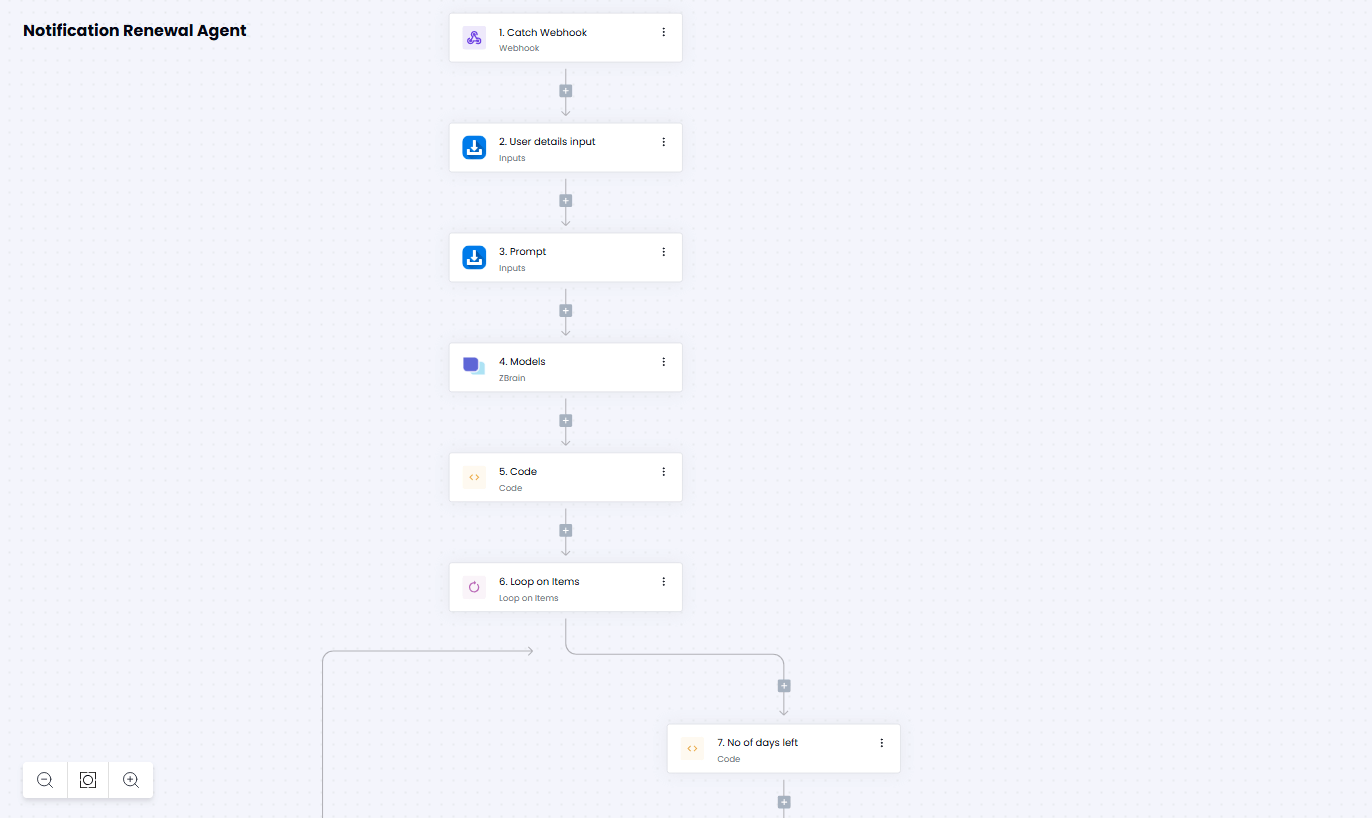
Agent Crew: Multi-agent scaffolding
Supervisor–subordinate hierarchy: ZBrain’s Agent Crew feature enables structured, multi-agent workflows, where a supervising agent orchestrates subordinate agents to tackle subtasks in sequence or in parallel.
Coordinated control loops: The supervisor delegates tasks, evaluates outputs, handles retries or fallbacks, and logs decisions, providing clear scaffolding for complex logic.
Streamline your operational workflows with ZBrain AI agents designed to address enterprise challenges.
Tool & external system integration
Broad tool library: Agent flows can connect to various tools, including databases, CRMs, ERP systems, ServiceNow, Apify (web scrapers), and OCR/document intelligence tools, among others, via built-in connectors.
MCP (Model Context Protocol) integration: ZBrain’s Agent Crew setup supports integration with external systems via MCP servers. Within the ‘Define crew structure’ step of the Agent Crew setup process, users can attach one or more MCP endpoints, enabling agents to send and receive data from proprietary APIs, custom services, or internal enterprise platforms. MCP servers are configured with a URL and optional headers—enabling flexible, authenticated communication pipelines across systems.
External package support: When creating a tool for an agent crew, users can also import external JavaScript dependencies. Developers can specify NPM packages or other modules directly within the agent tool interface. This allows advanced agents to execute complex logic, access third-party utilities, or extend their capabilities without switching environments. Version management is automatic, supporting fast upgrades and rollbacks if needed.
Context and memory management
Configurable memory scopes: ZBrain supports three memory modes per agent—no memory, crew memory, and tenant memory. This lets teams control how context is stored and reused. Agents in no memory mode start fresh with every input. Crew memory allows an agent to retain context within its own sessions, while tenant memory enables shared memory across all agents and sessions in the tenant. This setup supports precise control over memory persistence.
Event-driven processing: Flows can ingest data via webhooks, queues, or real-time sources, letting agents maintain context and adjust behavior over multi-step workflows.
Streamline your operational workflows with ZBrain AI agents designed to address enterprise challenges.
Robust execution and observability
Orchestration engine: Handles task sequencing, parallelism, conditional logic, execution timing, retries, and error handling automatically—key aspects of scaffolding.
Traceability and monitoring: Every agent call, tool usage, and execution step is logged and traceable, simplifying debugging and compliance.
Pre-built agent store
Off-the-shelf scaffolds: ZBrain offers prebuilt agents (e.g., for job description updates, RFQ screening, contract management, cash flows) that embody scaffolded logic and tool integration.
Easy customization: These agents can be deployed, configured, or extended, reducing scaffold design effort and accelerating time-to-value.
Enterprise-grade architecture
Model and cloud agnostic: ZBrain supports multiple LLMs (e.g., GPT-4, Claude, Gemini) and cloud environments, letting organizations choose the best fit for each agent.
Security and compliance: Connectors are managed through secure APIs; the orchestration engine enforces standardized communication and audit logs, critical for enterprise scaffolding.
Prompt scaffolding support
Prompt library: ZBrain Builder provides a dedicated prompt library module that allows users to create, manage, and reuse custom prompts across different agents. This module supports centralized prompt management and version control, making it easier to maintain consistency across agent behaviors.
Built-in prompt types: Within the Flow interface, users can select from a set of built-in prompt types. These include:
- Decomposition prompt: Helps agents break complex tasks into subtasks.
- Chain-of-thought (CoT) prompt: Guides agents to reason step-by-step before generating a final answer, improving logical coherence.
- Ensembling prompt: Aggregates multiple agent outputs for improved accuracy.
- Few-shot prompt: Provides the agent with examples to guide behavior.
- Self‑criticism prompt: Encourages agents to review and refine their own reasoning.
- Zero-shot prompt: Enables agents to tackle tasks without any examples.
These prompts can be directly integrated into flows, allowing for scaffold designs such as plan-then-act or critic-enhanced architectures within the low-code interface.
Retrieval-augmented Generation (RAG)
Knowledge base: Supports both vector-based and knowledge-graph indexing, selectable during ingestion.
Multi-source ingestion: Import data in various formats—PDFs, JSON, spreadsheets—from multiple sources like databases and cloud storage.
Incremental chunk ingestion: ZBrain supports graph-RAG knowledge bases where individual content chunks can be appended. This enables you to expand the knowledge graph over time, adding new data without requiring the re-upload or reprocessing of the entire dataset.
Semantic and hybrid search: Offers vector, full-text, and graph-based retrieval with configurable thresholds and K-values.
Retrieval testing: Validates the relevance and quality of retrieved chunks before pipeline deployment.
Using ZBrain for scaffolding
ZBrain Builder allows enterprises to create and customize agents by integrating their own data sources and configuring tools, workflows, memory settings, and logic through an intuitive interface. Users can build custom agents from scratch or customize pre-built agents, then visually orchestrate them using the Flow interface. ZBrain enforces standardized communication protocols (RESTful APIs/OpenAPI), allowing agents to function as modular, plug‑and‑play components. In essence, ZBrain Builder acts as the scaffolding layer—providing orchestration, agent catalog, and a unified knowledge base (vector + graph)—where LLM agents are configured, connected, and managed as part of structured workflows. For example, an organization can build an AI-based regulatory monitoring solution by chaining agents that monitor legislative documents, summarize updates, and alert compliance teams—all with low-code configuration.
In summary, ZBrain Builder allows teams to build, test, and deploy scaffolded agents without building scaffolding infrastructure from scratch, ensuring speed, reliability, and auditability in complex AI workflows.
Challenges, limitations, and best practices
While powerful, agent scaffolding comes with important pitfalls. Some key challenges include:
- Unpredictable or unsafe behavior: If not properly constrained, agents can behave erratically or execute unintended actions. Allowing LLMs to take actions (e.g., call code, browse the web) means that any flaws in their understanding can lead to errors—or even malicious behavior. Without guardrails, an agent might repeat actions in loops or execute harmful commands. Mitigation often requires human-in-the-loop checkpoints or safety filters.
- Complexity and debugging difficulty: Multi-agent systems are hard to monitor. When several LLMs interact, logs can be confusing, and it may be unclear why one agent made a decision. Debugging agent interactions is often hard. State management (ensuring each agent sees the right memory/context) adds complexity. Best practice is to log every agent decision and maintain clear task breakdowns.
- Token and context limits: LLMs have finite context windows. Long-running scaffolds risk overflowing prompts with history. Agents must intelligently prune or summarize memory. Frameworks vary in how they manage context; developers should design concise prompts and use vector databases to offload old data.
- Data silos and integration: Many scaffolds rely on integrated data sources and tools. Setting up connectors (to databases, APIs, enterprise systems) can be labor-intensive. Poor integration can make the agent fragile. It’s essential to establish a robust abstraction layer (similar to Anthropic’s Model Context Protocol) so that agents can safely interact with tools without compromising credentials or violating business rules.
- Cost and performance: Multi-step agent workflows can trigger several LLM and tool calls, especially when reasoning is distributed across multiple agents. This can lead to increased latency and usage costs. The exact number of calls depends on the agent’s architecture, with complex processes potentially resulting in dozens of interactions per task. Enterprises should optimize prompts, consider using smaller models for less complex tasks, and evaluate on-premise or cost-efficient model hosting options to maintain scalability.
- Security and compliance: Granting agents tool access (such as email or financial systems) introduces security risks. There must be strict input validation, logging of all actions, and the establishment of audit trails. Frameworks often lack built-in auditing, so teams should add their own controls (e.g., token bucket limits, access controls).
- Model limitations: While agents rely on the underlying LLM for reasoning, their overall effectiveness is shaped by how well they’re scaffolded with tools, memory, and orchestration logic. Difficult logic or knowledge gaps can cause failure. Tasks should be decomposed so that no single agent call requires enormous reasoning leaps.
Best practices for scaffolded agents include:
- Define clear objectives and scope: Start with a precise goal and success criteria for the agent. Vague ambitions lead to scope creep.
- Break tasks into steps: Decompose complex tasks into sub-tasks that the LLM can handle (as in chain-of-thought or Factored Cognition). Use separate agents or prompts for planning vs execution.
- Separate logic from memory: Keep agent logic (such as prompt templates and flow control) distinct from retained knowledge (stored facts, documents, or records). Use structured memory—like vector databases or programmatic data stores—to retain this information and only send relevant context to the LLM. This approach keeps the system inspectable and avoids unnecessary model load.
- Use interpretable intermediate outputs: Encourage agents to reason in text or code that can be audited. Most of an LLM’s reasoning occurs internally and is not directly interpretable, whereas reasoning managed by the agent scaffold—such as planning, tool use, or memory access—is transparent and easier to debug. For example, have agents list their reasoning steps or log reasoning to a file. This makes behaviors easier to trace.
- Implement safety checks: Incorporate validators or critics at key junctures. For instance, before executing an agent’s action, run a secondary check (another model or ruleset) to approve it. Limit agent loops with max-iteration counters or termination controls such as kill switches.
- Leverage modular tools: Provide agents with well-defined, task-specific tools and APIs. The scaffold should translate high-level agent decisions into function calls that are validated and controlled, ensuring safe and predictable execution. Design these tool interfaces clearly (document parameters and outputs) so the LLM uses them correctly.
- Monitor and log aggressively: Record every agent input/output, tool calls, and system decisions. Use dashboards or alerts for failures. This not only aids debugging but also helps in aligning behavior with expectations.
- Iterate and test with feedback: Continuously refine prompts and flows based on failure cases. Pushing the LLM to its limits during testing exposes latent capabilities or failure modes.
- Control chain-of-command: If multiple agents collaborate, restrict unnecessary autonomy. For example, use a hierarchy or enforce an SOP (standard operating procedure) so agents call each other in a safe, predictable order (as MetaGPT does by simulating team roles).
- Align with enterprise governance: Especially for corporate use, agents should comply with policies (data handling, privacy). Any external calls or data retrieval must follow compliance rules. The scaffolding layer can enforce these (e.g., by sanitizing user input or masking private info).
By following these practices, teams can harness scaffolding to build more reliable AI agents. Documentation and training are also crucial: ensure that developers and stakeholders understand the agent architecture and know how to intervene if something goes wrong.
Endnote
Agent scaffolding is no longer just a research concept—it’s the practical foundation behind enterprise-ready AI agents. From simple task wrappers to multi-step reasoning loops and memory-driven workflows, the scaffold determines how intelligently and reliably a model can operate in real-world settings.
Understanding different scaffold types helps teams design agents that are not only accurate but also maintainable and aligned with business objectives. Whether you’re exploring prompt templates, retrieval-based augmentation, or full agent loops with planning and tool use, the scaffolding you choose will directly impact the agent’s success.
ZBrain provides the full scaffolding infrastructure required to move from experiments to production. Whether you are building a single-agent flow or deploying a multi-agent system with memory and external integrations, ZBrain offers the modular control, transparency, and scalability needed to support real-world AI outcomes.
Leverage ZBrain Builder to design, test, and deploy scaffolded agents that work with your data, tools, and workflows. Start building today.
Listen to the article
Author’s Bio

An early adopter of emerging technologies, Akash leads innovation in AI, driving transformative solutions that enhance business operations. With his entrepreneurial spirit, technical acumen and passion for AI, Akash continues to explore new horizons, empowering businesses with solutions that enable seamless automation, intelligent decision-making, and next-generation digital experiences.
Table of content
- What is agent scaffolding?
- Types of agent scaffolds
- Core scaffolding components and architecture
- Origins and evolution of the concept
- Functional scaffolding techniques
- Use cases and examples of agent scaffolding
- ZBrain Builder: A platform for building scaffolded agents at enterprise scale
- Challenges, limitations, and best practices
Frequently Asked Questions
What is agent scaffolding in AI?
Agent scaffolding refers to the supporting architecture and logic built around a large language model to enable it to act as an agent. This includes structured prompts, control flows, memory modules, tool interfaces, and decision loops that help the model perform complex tasks reliably.
How does ZBrain support agent scaffolding?
ZBrain offers a low-code interface for building and deploying LLM agents with configurable scaffolding. Users can define planning logic, memory use, tool access, and multi-agent workflows without extensive coding. ZBrain also supports enterprise integration, role-based access, and model flexibility, making agent scaffolding easier to manage at scale.
Can ZBrain agents interact with external tools or APIs?
Yes. ZBrain agents can access and interact with external tools, APIs, and enterprise systems like CRMs and ERPs. Tool use is managed through ZBrain’s Flow interface, where each step in the agent’s workflow can be set up to invoke specific tools as needed. Through the platform interface, users can define which tools an agent can access at each step—without writing backend code.
For multi-agent workflows built using Agent Crew, ZBrain’s MCP ensures that only relevant tool responses and context are passed to the LLM at each stage. This helps keep executions efficient, avoids unnecessary token usage, and ensures tighter control over what the model processes.
Does ZBrain support multi-agent scaffolds?
Yes. ZBrain supports Agent Crew, a multi-agent scaffold structure where a supervisor agent coordinates multiple specialized subordinate agents. Each agent can have its own toolset and MCP server integration. This is useful for complex workflows that require task decomposition and coordination.
How do we get started with ZBrain for AI development?
To begin your AI journey with ZBrain:
-
Contact us at hello@zbrain.ai
-
Or fill out the inquiry form on zbrain.ai
Whether you have a clear scope or just an idea, our team will guide you from strategy to execution.
Insights
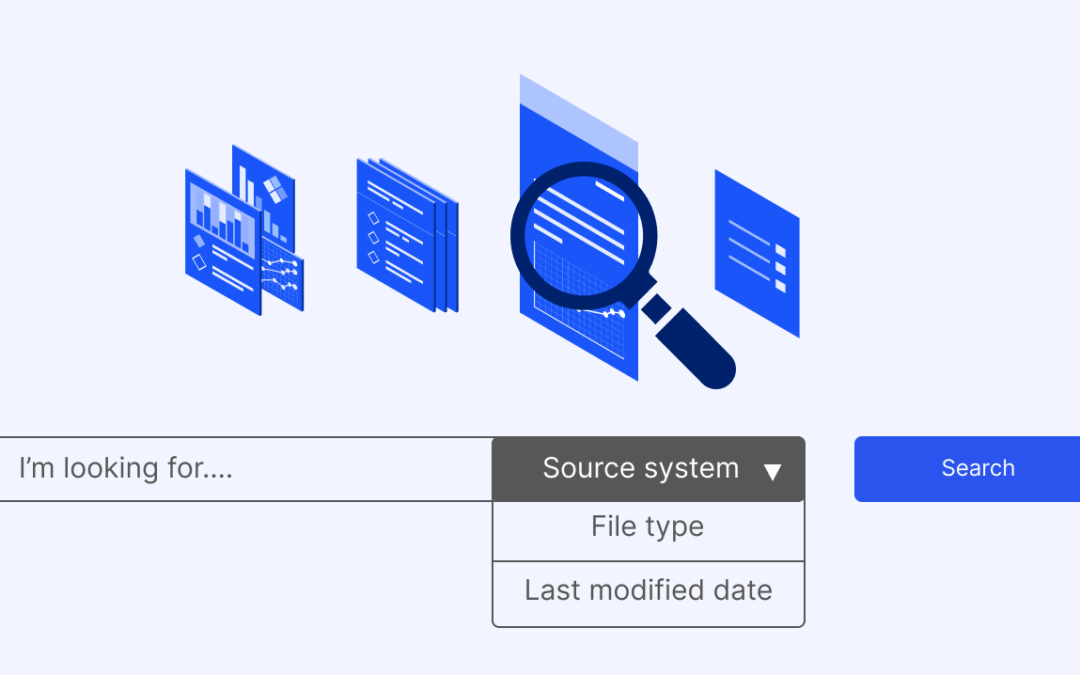
What is an enterprise search engine? A guide to AI-powered information access
An enterprise search engine is a specialized software that enables users to securely search and retrieve information from across an organization’s internal data sources and systems.

A comprehensive guide to AgentOps: Scope, core practices, key challenges, trends, and ZBrain implementation
AgentOps (agent operations) is the emerging discipline that defines how organizations build, observe and manage the lifecycle of autonomous AI agents.
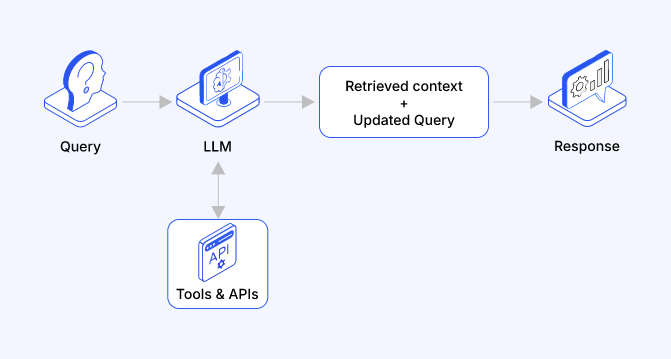
Adaptive RAG in ZBrain: Architecting intelligent, context-aware retrieval for enterprise AI
Adaptive Retrieval-Augmented Generation refers to a class of techniques and systems that dynamically decide whether or not to retrieve external information for a given query.
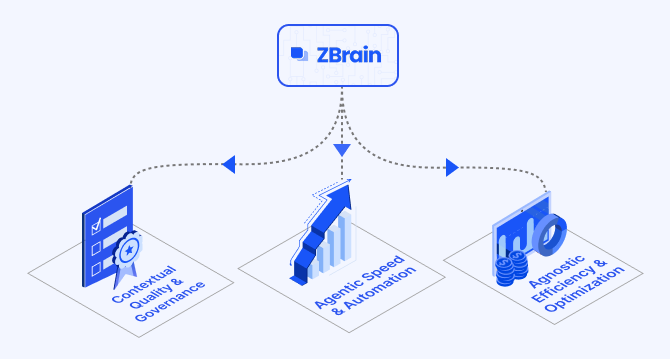
How ZBrain breaks the trade-offs in the AI iron triangle
ZBrain’s architecture directly challenges the conventional AI trade-off model—the notion that enhancing one aspect inevitably compromises another.
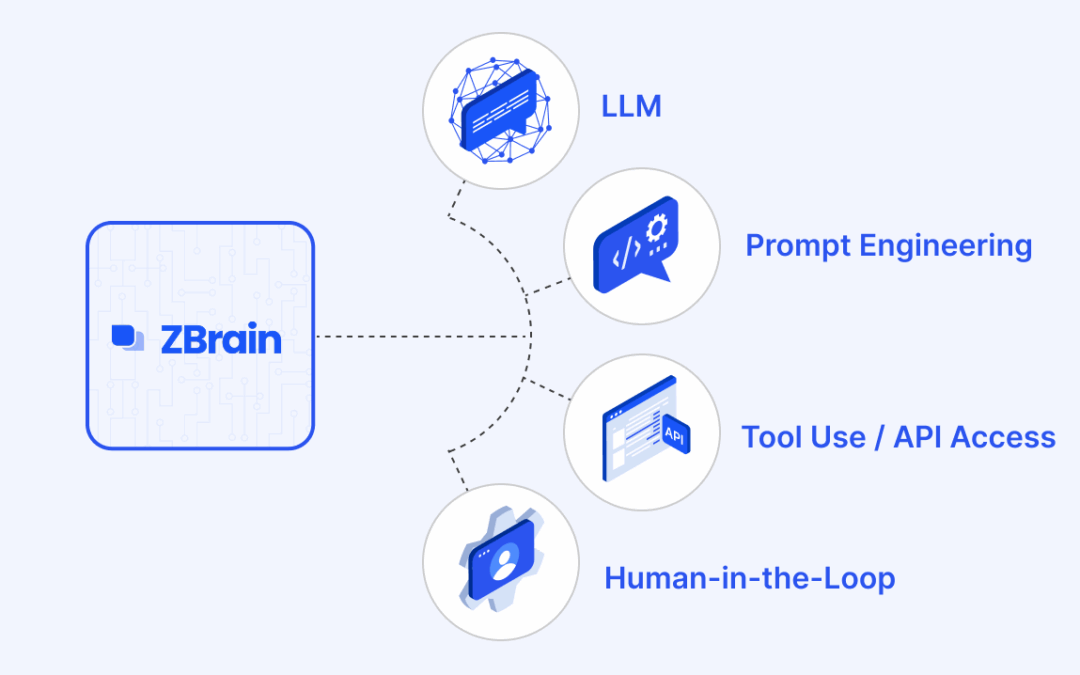
ZBrain Builder’s AI adaptive stack: Built to evolve intelligent systems with accuracy and scale
ZBrain Builder’s AI adaptive stack provides the foundation for a modular, intelligent infrastructure that empowers enterprises to evolve, integrate, and scale AI with confidence.
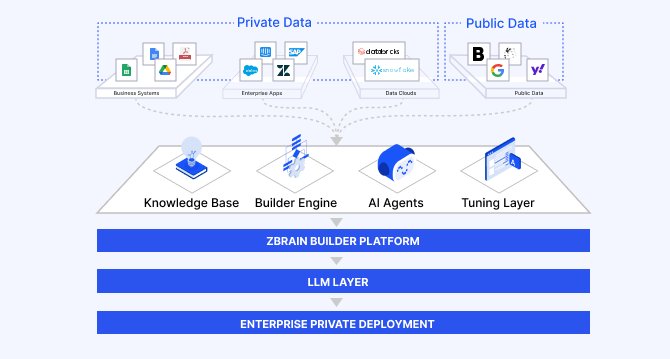
Automated AI workflows with ZBrain: Flows, LLM agents and orchestration patterns
ZBrain enables enterprises to design workflows that are intuitive for teams, efficient in execution, and adaptable to evolving business needs—transforming automation into a strategic advantage.
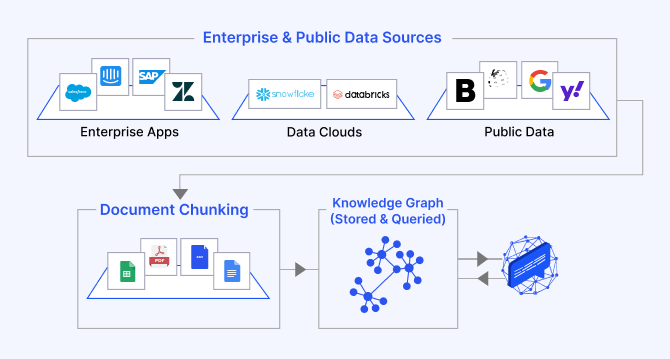
The role of knowledge graphs in building agentic AI systems: Architecture, reasoning, and ZBrain’s implementation
ZBrain Builder leverages knowledge graphs to improve contextual precision and enable reliable multi-hop reasoning in its agent responses.

ZBrain Builder: The agnostic agentic AI platform redefining enterprise AI orchestration
ZBrain Builder simplifies many aspects of AI development through its low-code interface and agnostic integration capabilities, maximizing its value depends on thoughtful planning across deployment, configuration, governance, and integration.
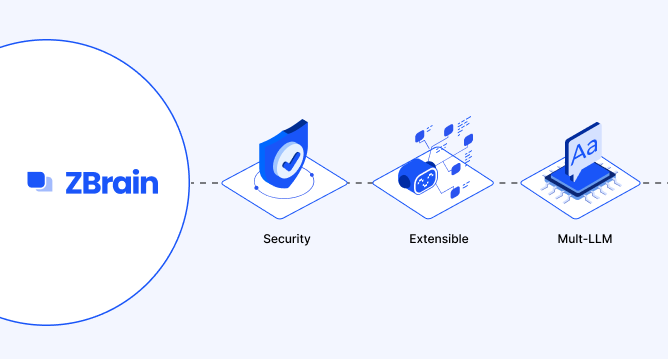
How ZBrain Builder accelerates enterprise delivery with low-code development
Low-code development and generative AI are two transformative forces that converge in ZBrain Builder to create a potent platform for enterprise innovation.



